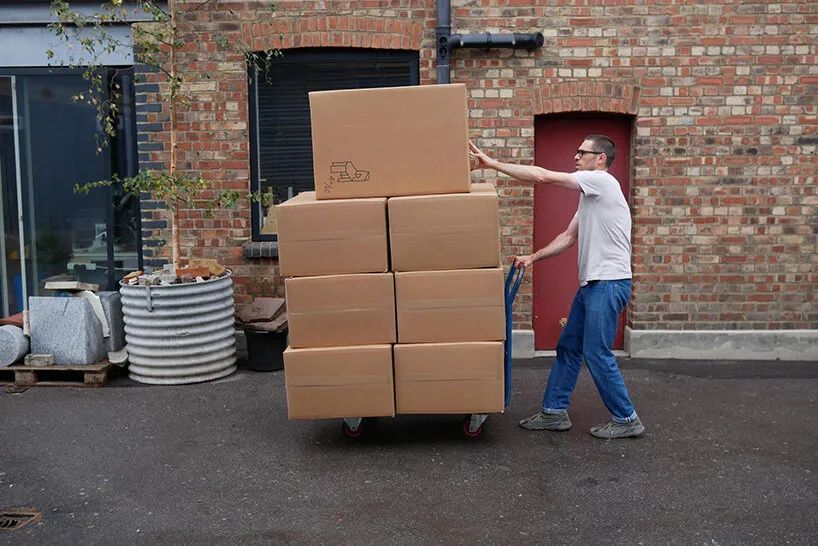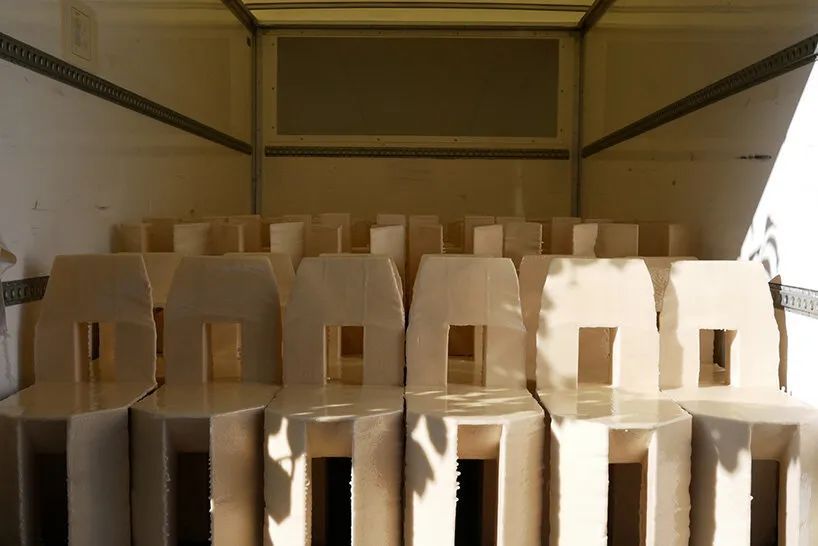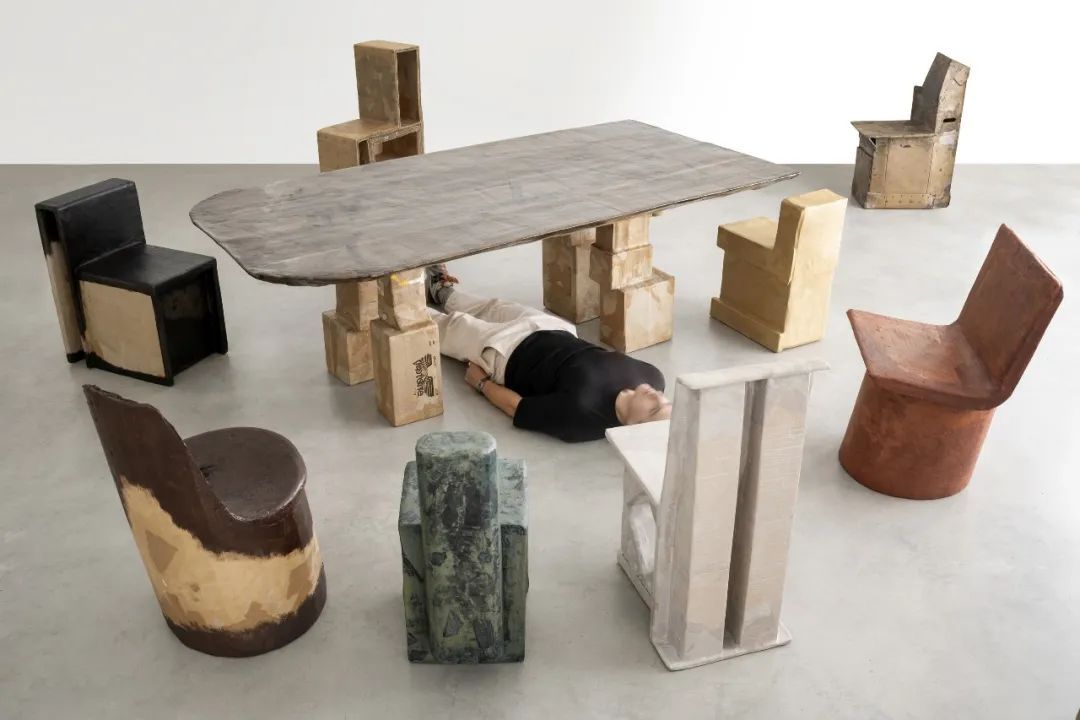Max Lamb's Boxes
)
Max Lamb, aged 43, was born in Cornwall in 1980. His interest in design began at a young age, leading him to pursue studies in Art and Design at Amersham & Wycombe College in 2000, where he garnered several awards. Drawing inspiration from his surroundings, this designer transforms diverse materials, including stone, wood, metal, plastic, and unexpected elements, into his creative experiments.
“To design is to think, to be conscious. To design is to have conscience, to help, to have hope. To design is to believe—to play.”
——Max Lamb
Exercises in Seating
In Max Lamb's creations, he consistently seeks opportunities to infuse individuality into ever-evolving themes, leaving distinct imprints on materials and craftsmanship. In the "Exercise in Seating" exhibition of 2015, Lamb meticulously crafted a variety of works using stone, wood, textiles, polystyrene, and various metals, seamlessly blending design, art, and functional objects into captivating new forms.

This series of works traces back to 2005 when Max Lamb, then a sophomore in university, embarked on a journey of self-discovery as a designer. "I really wanted to know who I am as a designer or what kind of person I could become... That's when I realized I always needed to involve my hands as much as possible in design, but I also recognized my proficiency in experimentation."
However, for a young designer, proclaiming "I want to make ten thousand things" is a challenging endeavor. For Max Lamb, the significance of the "Exercise in Seating" lies in choosing a type, namely chairs, and exploring as many variables as possible within this realm. Subsequently, Max Lamb has maintained a hands-on approach in his work, leading him into a prolific and customized creative state.
"This is what I've always been doing—spending a lot of time exploring the concept of value—monetary value, emotional value, and so on. At that time, I was very dissatisfied with the design of homogenization and global consumption."
——Max Lamb,Interviewed by Nude Paper
In a project in 2020, Max Lamb handcrafted 60 chairs using polystyrene sheets over three days. These chairs explore the tension between individual preferences and mass production forms: "If you observe the outline of each chair, you'll notice a repetition, but upon closer examination, you'll discover personality embedded within."


In the project "My Grandfather's Tree," he meticulously dissected a 187-year-old wax tree that was felled on his grandfather's farm—both to commemorate his grandfather and to give this magnificent tree a second life as tables and chairs.
While opposing mass production and anti-industrial design, his attitude is not radical but rather infused with humor. Perhaps for us, the processes and raw materials behind manufacturing are often unclear, but in Max Lamb's designs, the concept remains ever-present: "Objects are created by people and translated for the users."
Turning Paper Boxes into Chairs
As he puts it, "Climbing into the deepest quarries in Portugal or ascending the mountains of Italy, using raw materials directly on-site." Max Lamb has a habit of preserving a variety of collected materials. In his latest project this year, he has transformed one of the most common and easily overlooked materials into a playful and whimsical design game.
"I've been working hard to sustain my momentum. Although I usually think carefully about where to source materials, now I have no choice but to find materials locally as much as possible. Every piece of material I've accumulated in and around the studio over the past six years, I use to maintain a bit of progress."
——Max Lamb,Interviewed by Nude Paper
Cardboard boxes are ubiquitous in our lives—they protect our online purchases, transport our belongings when we move, and can be used to store or transport nearly any product. In terms of packaging materials, they are incredibly sustainable due to their ability for infinite recycling. However, in all these applications, the cardboard box is just a supporting actor.
"I've always kept cardboard boxes with the aim of transforming them into more permanent, practical items with primary functions rather than secondary ones." Max Lamb seeks to subvert our perception of this material, with over 30 pieces in "Boxes," exploring different scales: from small stools and bowls to armchairs and coffee tables. The largest piece is a "monster" dining table composed of stacked cardboard boxes; there's even a waste paper basket. The new pieces not only explore different scales but also a variety of craft techniques. Some boxes are stacked; some are cut with blades, fundamentally altering their shapes, while others are completely broken down into pulp for surface applications, achieving more organic, softer forms.

Max Lamb approaches his creations in a speculative manner but with a focus on providing users with more choices. Starch-based glue, primarily composed of flour and water, serves as the adhesive. This ensures minimal pollution, and all materials can be readily reintroduced into the next cycle, easily repaired at home: "It's really simple, with excellent accessibility and cleanliness—we can mess around as we please, and if we want to, we can actually lick our hands clean!"
His attention to materials, or "reverence," stems from the idea that "the material world requires thoughtful and responsible consideration." His design philosophy revolves around a fundamental understanding of the physical properties, tools, and processes of the materials he works with, whether it's low-tech tools like hammers and chisels or high-tech products like 3D printing. Deep knowledge of these materials and processes is essential to excel in this work.
All of this is conveyed in a concise, articulate language that exudes a readable honesty: "I want my work to be clear, literal, but not shallow. If someone likes it, then I'm happy."

